Mitsubishi PLFY-P20VCM-E(1), PLFY-P25VCM-E(1), PLFY-P32VCM-E(1), PLFY-P40VCM-E(1) Service Manual
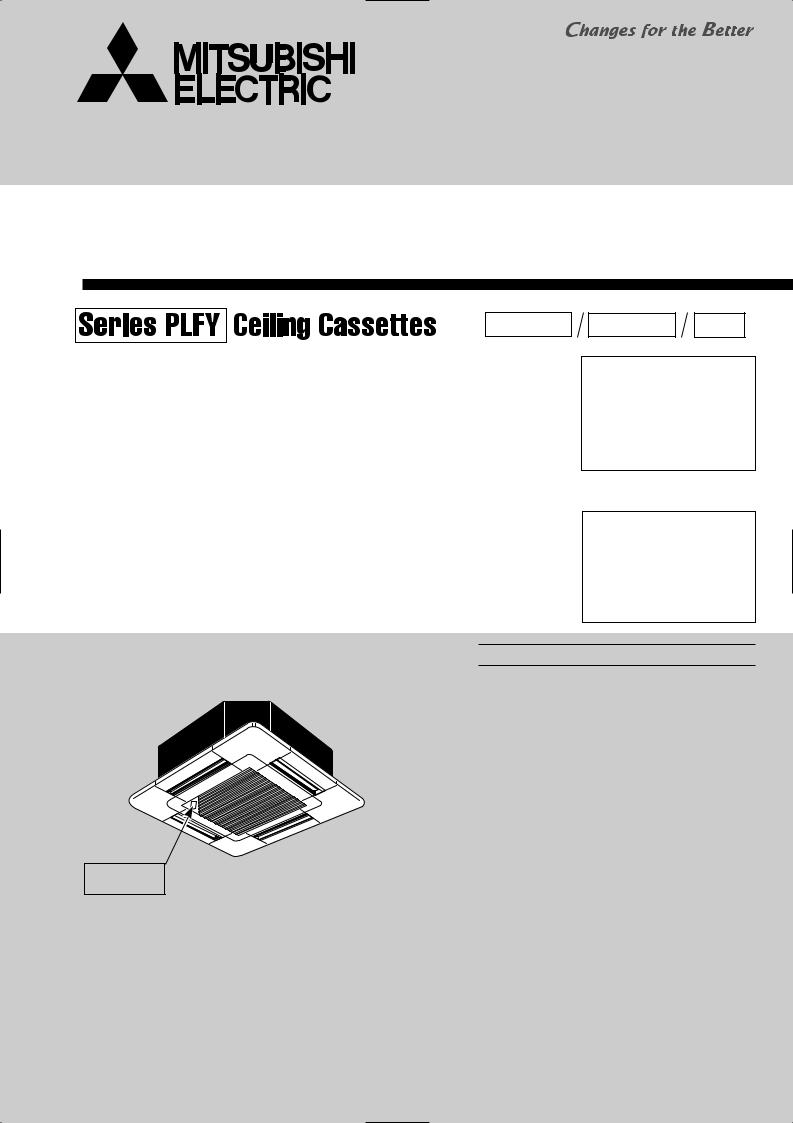
SPLIT-TYPE, HEAT PUMP AIR CONDITIONERS
July 2007
No.OC314
REVISED EDITION-C
TECHNICAL & SERVICE MANUAL
Indoor unit [Model names]
PLFY-P20VCM-E
PLFY-P25VCM-E
PLFY-P32VCM-E
PLFY-P40VCM-E
R410A |
R407C |
R22 |
[Service Ref.]
PLFY-P20VCM-E.TH PLFY-P20VCM-E1.TH PLFY-P25VCM-E.TH PLFY-P25VCM-E1.TH PLFY-P32VCM-E.TH PLFY-P32VCM-E1.TH PLFY-P40VCM-E.TH PLFY-P40VCM-E1.TH
Revision :
•PLFY-P20/25/32/40VCM- E1.TH are added in REVISED EDITION-C.
•Some descriptions have been modified.
•Please void OC314 REVISED EDITION-B.
Note :
•RoHS compliant products have <G> mark on spec name plate.
For servicing RoHS compliant products, refer to the RoHS Parts List.
|
|
CONTENTS |
|
|
|
1. TECHNICAL CHANGES·········· |
|
|
|
2. SAFETY PRECAUTION··········· |
|
|
|
3. PART NAMES AND FUNCTIONS ······ |
|
|
|
4. SPECIFICATIONS············· |
|
|
|
5. 4-WAY AIR FLOW SYSTEM········· |
|
|
|
6. OUTLINES AND DIMENSIONS······· |
|
|
|
7. WIRING DIAGRAM············ |
|
|
|
8. REFRIGERANT SYSTEM DIAGRAM ····· |
|
|
|
9. DISASSEMBLY PROCEDURE······· |
|
Model name |
INDOOR UNIT |
10 . TROUBLESHOOTING··········· |
|
11. PARTS LIST················ |
|||
|
|||
indication |
|
||
|
12. RoHS PARTS LIST············ |
||
|
|
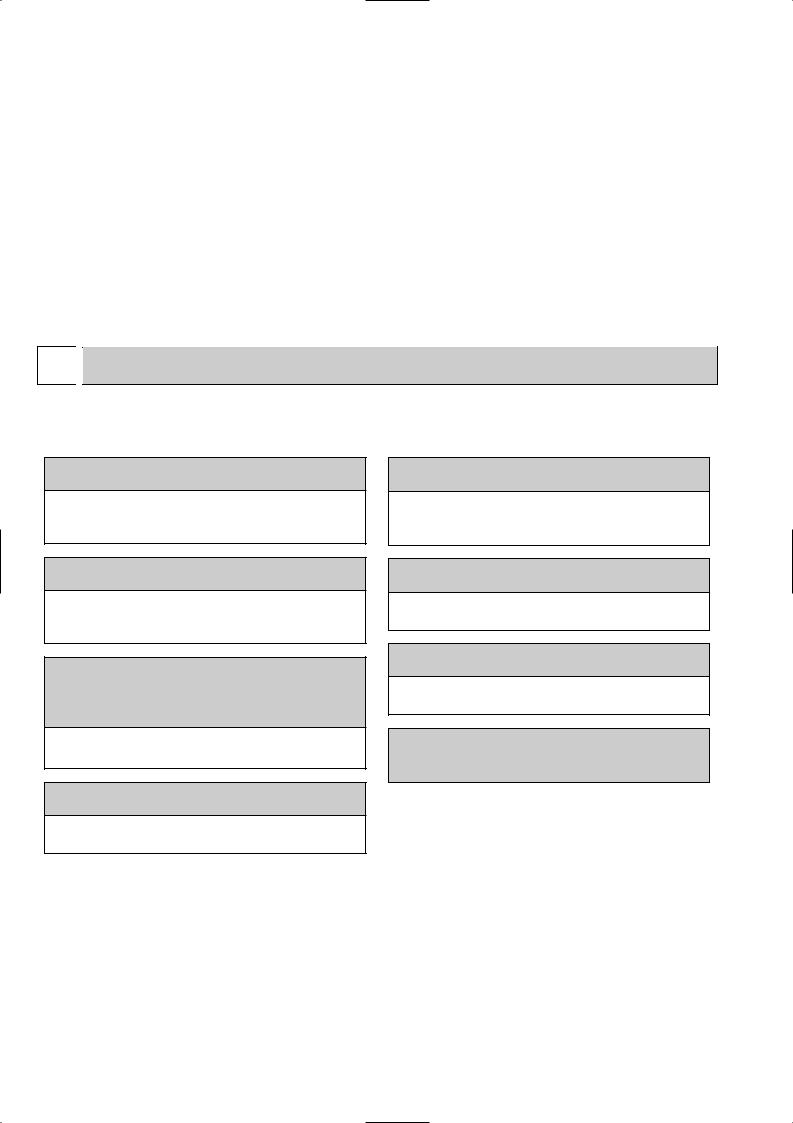
1 |
|
TECHNICAL CHANGES |
|
|
|||
|
|
|
|
PLFY-P20VCM-E.TH |
PLFY-P20VCM-E1.TH |
||
PLFY-P25VCM-E.TH |
PLFY-P25VCM-E1.TH |
||
PLFY-P32VCM-E.TH |
PLFY-P32VCM-E1.TH |
||
PLFY-P40VCM-E.TH |
PLFY-P40VCM-E1.TH |
||
• PANEL has been changed. |
|
||
SLP-2AA(White : 0.70Y 8.59/0.97) |
SLP-2AAW(Pure white : 6.4Y 8.9/0.4) |
||
2 
 SAFETY PRECAUTION
SAFETY PRECAUTION
CAUTIONS RELATED TO NEW REFRIGERANT
Cautions for units utilizing refrigerant R407C
Do not use the existing refrigerant piping.
The old refrigerant and lubricant in the existing piping contains a large amount of chlorine which may cause the lubricant deterioration of the new unit.
Use “low residual oil piping”
If there is a large amount of residual oil (hydraulic oil, etc.) inside the piping and joints, deterioration of the lubricant will result.
Store the piping to be used during installation indoors with keep both ends sealed until just before brazing.
(Store elbows and other joints in a plastic bag.)
If dust, dirt, or water enters the refrigerant cycle, deterioration of the oil and compressor trouble may result.
Use ESTR , ETHER or HAB as the lubricant to coat flares and flange connection parts.
If large amount of mineral oil enters, that can cause deterioration of refrigerant oil etc.
[1] Cautions for service
Use liquid refrigerant to charge the system.
If gas refrigerant is used to seal the system, the composition of the refrigerant in the cylinder will change and performance may drop.
Do not use a refrigerant other than R407C.
If another refrigerant (R22, etc.) is used, the chlorine in the refrigerant may cause the lubricant deterioration.
Use a vacuum pump with a reverse flow check valve.
The vacuum pump oil may flow back into the refrigerant cycle and cause the lubricant deterioration.
Ventilate the room if refrigerant leaks during operation. If refrigerant comes into contact with a flame, poisonous gases will be released.
·After recovering the all refrigerant in the unit, proceed to working. ·Do not release refrigerant in the air.
·After completing the repair service, recharge the cycle with the specified amount of liquid refrigerant.
2
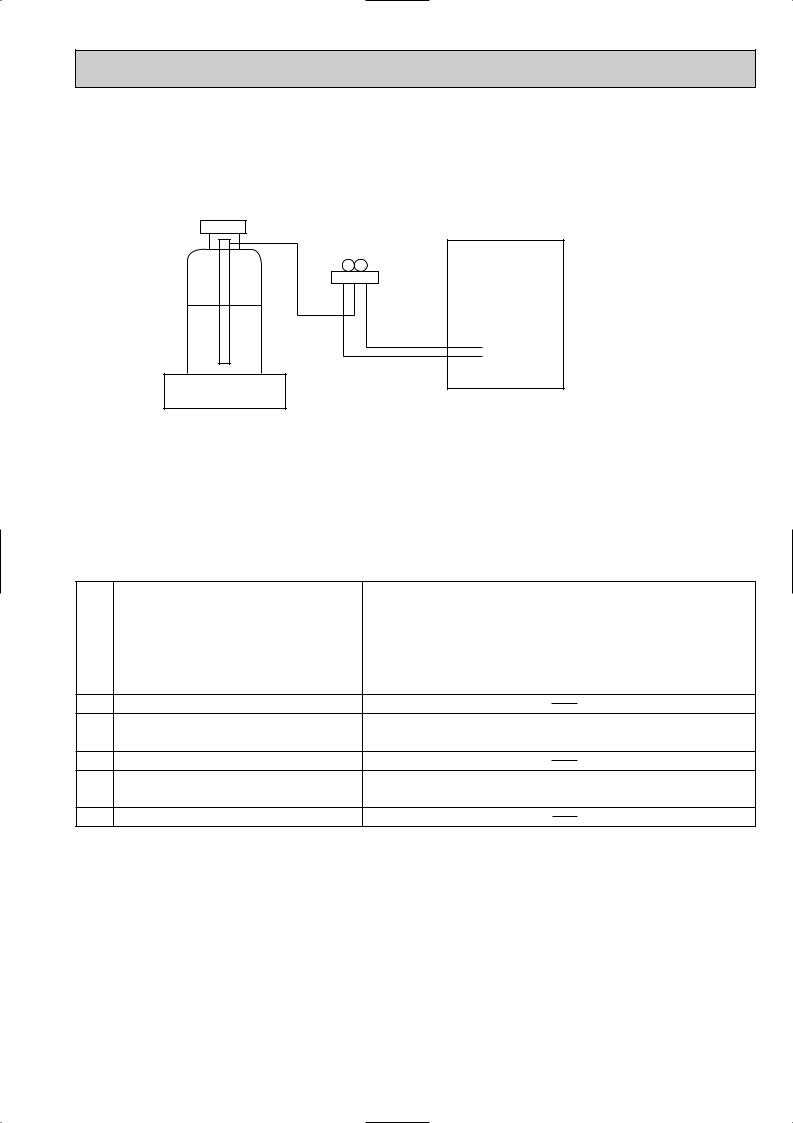
[2] Refrigerant recharging
(1) Refrigerant recharging process
1Direct charging from the cylinder
·R407C cylinder which is available on the market has a syphon pipe. ·Leave the syphon pipe cylinder standing and recharge it.
(By liquid refrigerant)
Unit
Gravimeter
(2) Recharge in refrigerant leakage case
·After recovering all the refrigerant in the unit, proceed to working. ·Do not release the refrigerant in the air.
·After completing the repair service, recharge the cycle with the specified amount of liquid refrigerant.
[3] Service tools
Use the below service tools as exclusive tools for R407C refrigerant.
No. |
Tool name |
Specifications |
1 |
Gauge manifold |
·Only for R407C |
|
|
|
|
|
·Use the existing fitting SPECIFICATIONS. (UNF7/16) |
|
|
|
|
|
·Use high-tension side pressure of 3.43MPa·G or over. |
|
|
|
2 |
Charge hose |
·Only for R407C |
|
|
|
|
|
·Use pressure performance of 5.10MPa·G or over. |
3Electronic scale
4 |
Gas leak detector |
·Use the detector for R134a or R407C. |
5 |
Adapter for reverse flow check |
·Attach on vacuum pump. |
6Refrigerant charge base
7 Refrigerant cylinder |
·For R407C |
·Top of cylinder (Brown) |
|
·Cylinder with syphon |
|
8Refrigerant recovery equipment
3
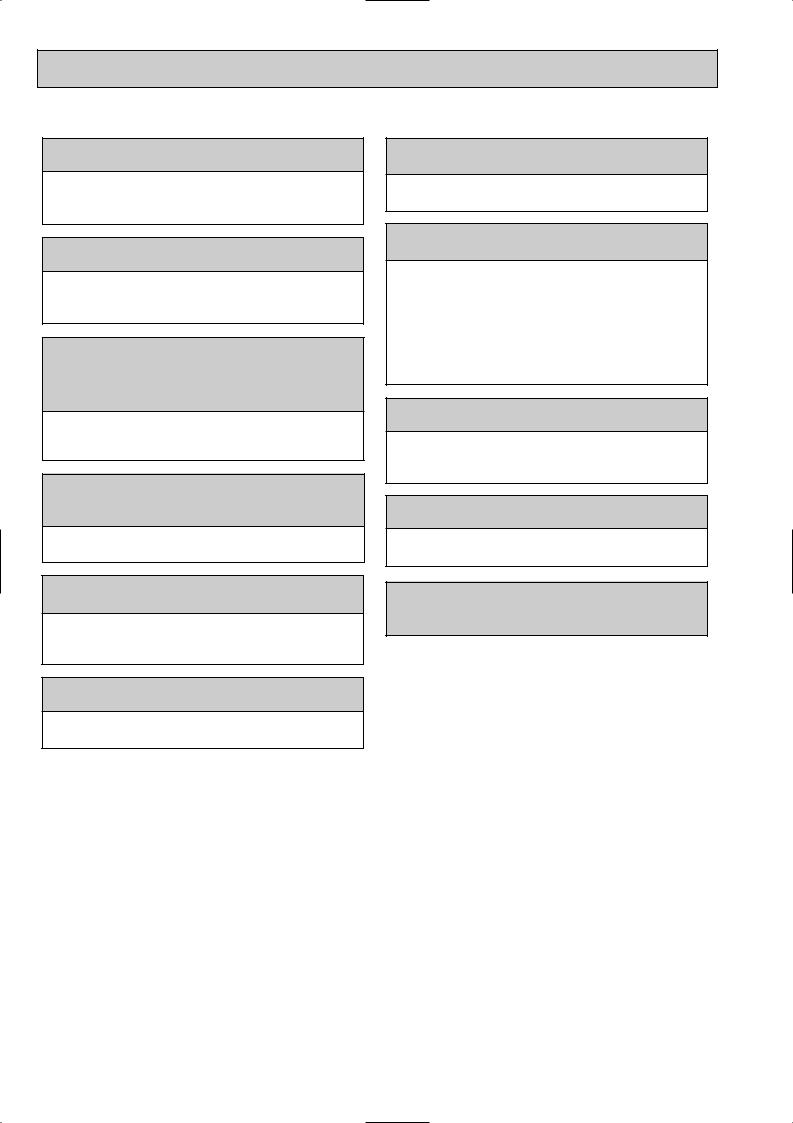
Cautions for units utilizing refrigerant R410A
Do not use the existing refrigerant piping.
The old refrigerant and lubricant in the existing piping contains a large amount of chlorine which may cause the lubricant deterioration of the new unit.
Use “low residual oil piping”
If there is a large amount of residual oil (hydraulic oil, etc.) inside the piping and joints, deterioration of the lubricant will result.
Store the piping to be used during installation indoors and keep both ends of the piping sealed until just before brazing. (Leave elbow joints, etc. in their packaging.)
If dirt, dust or moisture enters into refrigerant cycle, that can cause deterioration of refrigerant oil or malfunction of compressor.
Use ester oil, ether oil or alkylbenzene oil (small amount) as the refrigerant oil applied to flares and flange connections.
If large amount of mineral oil enters, that can cause deterioration of refrigerant oil etc.
Charge refrigerant from liquid phase of gas cylinder.
If the refrigerant is charged from gas phase, composition change may occur in refrigerant and the efficiency will be lowered.
Do not use refrigerant other than R410A.
If other refrigerant (R22 etc.) is used, chlorine in refrigerant can cause deterioration of refrigerant oil etc.
Use a vacuum pump with a reverse flow check valve.
Vacuum pump oil may flow back into refrigerant cycle and that can cause deterioration of refrigerant oil etc.
Use the following tools specifically designed for use with R410A refrigerant.
The following tools are necessary to use R410A refrigerant.
|
Tools for R410A |
|
Gauge manifold |
|
Flare tool |
Charge hose |
|
Size adjustment gauge |
Gas leak detector |
|
Vacuum pump adaptor |
Torque wrench |
|
Electronic refrigerant |
|
|
charging scale |
|
|
|
Keep the tools with care.
If dirt, dust or moisture enters into refrigerant cycle, that can cause deterioration of refrigerant oil or malfunction of compressor.
Do not use a charging cylinder.
If a charging cylinder is used, the composition of refrigerant will change and the efficiency will be lowered.
Ventilate the room if refrigerant leaks during operation. If refrigerant comes into contact with a flame, poisonous gases will be released.
4

[1]Cautions for service
(1)Perform service after recovering the refrigerant left in unit completely.
(2)Do not release refrigerant in the air.
(3)After completing service, charge the cycle with specified amount of refrigerant.
(4)When performing service, install a filter drier simultaneously. Be sure to use a filter drier for new refrigerant.
[2]Additional refrigerant charge
When charging directly from cylinder
·Check that cylinder for R410A on the market is syphon type.
·Charging should be performed with the cylinder of syphon standing vertically. (Refrigerant is charged from liquid phase.)
Unit
Gravimeter
[3] Service tools
Use the below service tools as exclusive tools for R410A refrigerant.
No. |
Tool name |
Specifications |
1 |
Gauge manifold |
·Only for R410A |
|
|
|
|
|
·Use the existing fitting specifications. (UNF1/2) |
|
|
|
|
|
·Use high-tension side pressure of 5.3MPa·G or over. |
|
|
|
2 |
Charge hose |
·Only for R410A |
|
|
|
|
|
·Use pressure performance of 5.09MPa·G or over. |
3Electronic scale
4 |
Gas leak detector |
·Use the detector for R134a, R407C or R410A. |
|
|
|
5 |
Adaptor for reverse flow check |
·Attach on vacuum pump. |
6Refrigerant charge base
7 Refrigerant cylinder |
·Only for R410A |
·Top of cylinder (Pink) |
|
·Cylinder with syphon |
|
8Refrigerant recovery equipment
5
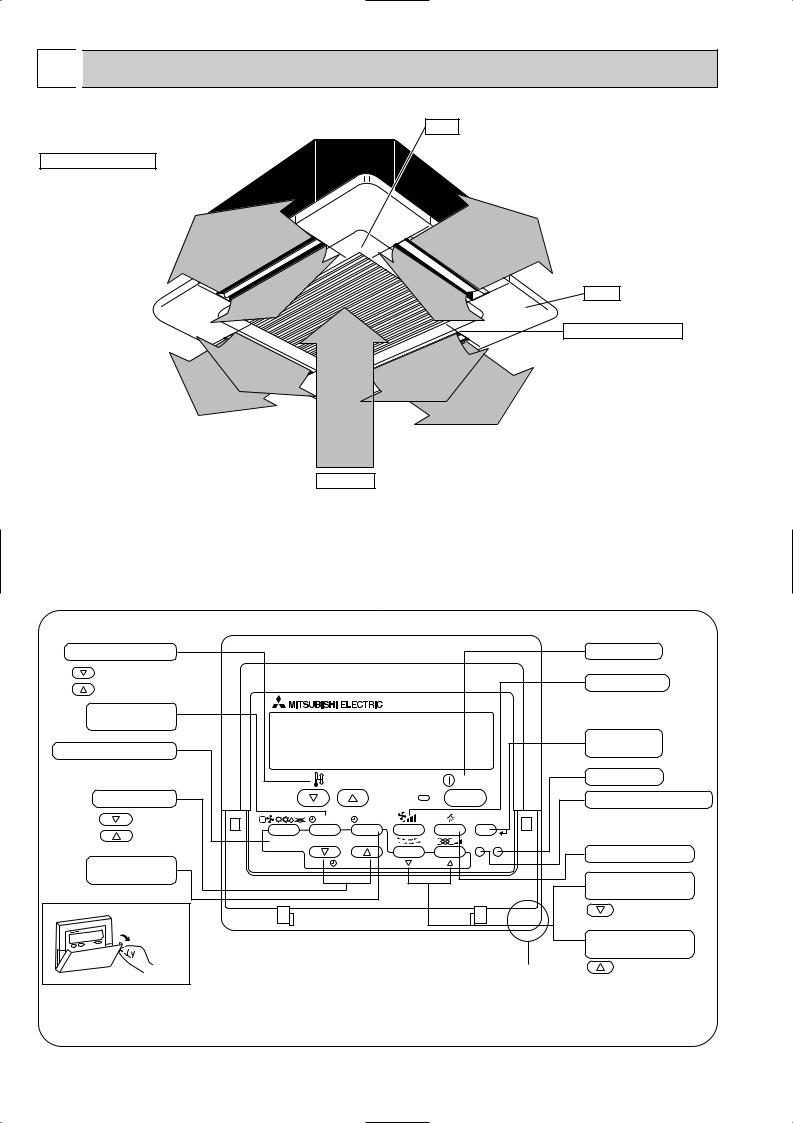
3 
 PART NAMES AND FUNCTIONS
PART NAMES AND FUNCTIONS
● Indoor Unit
Horizontal Air Outlet
Sets horizontal airflow automatically during cooling or dehumidifying.
Filter
Remove dust and pollutants from inhaled air.
Grille
Auto Air Swing Vane
Disperses airflow up and down and adjusts the angle of airflow direction.
Air Intake
Inhales air from room.
● Wired remote controller
Once the controllers are set, the same operation mode can be repeated by simply pressing the ON/OFF button.
Temperature setting buttons |
|
|
|
Down |
|
|
|
Up |
|
|
|
Timer Menu button |
|
|
|
(Monitor/Set button) |
|
|
|
Mode button (Return button) |
|
|
|
|
|
TEMP. |
|
Set Time buttons |
|
|
|
Back |
|
MENU |
ON/OFF |
Ahead |
BACK |
MONITOR/SET |
DAY |
|
|||
Timer On/Off button |
PAR-21MAA |
CLOCK |
|
(Set Day button) |
|
|
|
Opening the |
|
|
|
lid |
|
|
|
|
ON/OFF |
|
|
FILTER |
|
|
CHECK |
TEST |
OPERATION |
CLEAR |
|
Built-in temperature sensor
ON/OFF button
Fan Speed button
Filter  button (<Enter> button)
button (<Enter> button)
Test Run button
Check button (Clear button)
Airflow Up/Down button
Louver button
( Operation button)
Operation button)
To return operation number
Ventilation button
( Operation button)
Operation button)
To go to next operation number
6
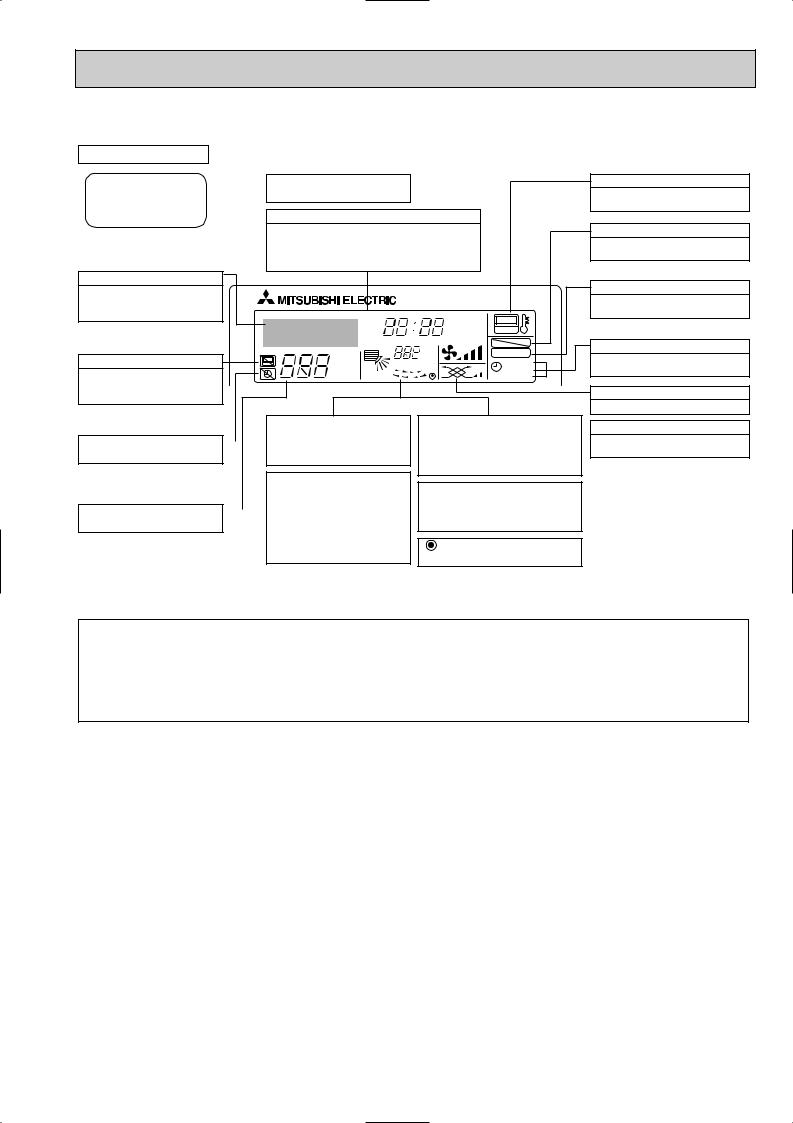
● Wired remote controller
Display Section
For purposes of this explanation, |
Day-of-Week |
all parts of the display are shown |
Shows the current day of the week. |
as lit. During actual operation, only |
|
the relevant items will be lit. |
Time/Timer Display |
Shows the current time, unless the simple or Auto Off timer is set.
If the simple or Auto Off timer is set, the time to be switched off is shown.
Identifies the current operation
Shows the operating mode, etc. *Multilanguage display is available.
|
TIME SUN MON TUE WED THU FRI SAT |
||
|
TIMER |
Hr |
ON |
|
AFTER |
AFTER |
OFF |
|
ERROR CODE |
|
FUNCTION |
|
˚F˚C |
|
FILTER |
“Centrally Controlled” indicator |
˚F˚C |
|
|
|
WEEKLY |
||
Indicates that operation from the |
ONLY1Hr. |
|
SIMPLE |
|
AUTO OFF |
||
remote controller has been prohib- |
|
|
|
ited by a master controller.
|
|
|
|
|
Up/Down Air Direction indica- |
|
Room Temperature display |
“Timer is Off” indicator |
|
|
|
|
tor |
|
Shows the room temperature. The room |
|
|
|
|
Shows the direction of the |
|
temperature display range is 8~39:. |
|
Indicates that the timer is off. |
|
|
|
|
outcoming airflow. |
|
The display blinks if the temperature |
|
|
|
|
|
“One Hour Only” indicator |
|
is less than 8: or 39: or more. |
|
|
|
|
|
|
Louver display |
|
|
|
|
|
|
Displayed if the airflow is set to |
|
|
|
|
|
|
|
|
|
|
|
|
|
|
|
|
Indicates the action of the swing louver. |
|
Temperature Setting |
|
|
|
|
low or downward during COOL |
|
|
|
|
|
|
or DRY mode. (Operation varies |
|
Does not appear if the louver is not |
|
Shows the target temperature. |
|
|
|
|
according to model.) |
|
running. |
|
|
|
|
|
The indicator goes off in one hour, |
|
(Power On indicator) |
|
|
|
|
|
when the airflow direction also |
|
|
|
|
|
|
|
changes. |
|
Indicates that the power is on. |
“Sensor” indication
Displayed when the remote controller sensor is used.
“Locked” indicator
Indicates that remote controller buttons have been locked.
“Clean The Filter” indicator
To be displayed on when it is time to clean the filter.
Timer indicators
The indicator comes on if the corresponding timer is set.
Fan Speed indicator
Shows the selected fan speed.
Ventilation indicator
Appears when the unit is running in Ventilation mode.
Note:
●“PLEASE WAIT” message
This message is displayed for approximately 3 minutes when power is supplied to the indoor unit or when the unit is recovering from a power failure.
●“NOT AVAILABLE” message
This message is displayed if an invalid button is pressed (to operate a function that the indoor unit does not have).
If a single remote controller is used to operate multiple indoor units simultaneously that are different types, this message will not be displayed as far as any of the indoor units is equipped with the function.
7

4 
 SPECIFICATIONS
SPECIFICATIONS
4-1. SPECIFICATIONS
Item |
PLFY-P20VCM-E(1).TH |
PLFY-P25VCM-E(1).TH |
PLFY-P32VCM-E(1).TH |
PLFY-P40VCM-E(1).TH |
|
|
|
|
|
|
|
|
|
|
|
|
Power |
· |
|||
|
|
V Hz |
||||
Cooling capacity |
kW |
|||||
Heating capacity |
kW |
|||||
characteristic |
|
Input |
|
Cooling |
kW |
|
|
|
|||||
|
|
|
||||
|
|
|
Heating |
|
||
|
|
|
|
kW |
||
Electric |
|
Current |
|
Cooling |
A |
|
|
|
Heating |
A |
|||
|
|
|
|
|
||
|
|
|
|
|
|
|
|
|
Exterior |
— |
|||
(munsell symbol) |
||||||
|
||||||
|
|
|
|
Height |
mm |
|
|
|
|
|
|||
Dimensions |
|
Width |
mm |
|||
|
|
|
|
Depth |
mm |
|
Heat exchanger |
— |
|||||
|
|
Fan No |
— |
|||
|
|
|||||
n |
|
Air flow W3 |
k/min |
|||
a |
|
|||||
|
External |
|
||||
|
|
Pa |
||||
F |
|
static pressure |
||||
|
|
|||||
|
|
Fan motor |
kW |
|||
|
|
output |
||||
|
|
Insulator |
— |
|||
|
|
Air filter |
— |
|||
|
|
|
|
sideGas |
[mm(in.) |
|
|
Pipe |
|
||||
dimensions |
Liquidside [mm(in.) |
|||||
Field drain pipe size |
[mm |
|||||
Noise level W3 |
dB |
|||||
Product weight |
kg |
|||||
|
|
Single phase 220-230-240V 50Hz |
|||
2.2 |
|
|
|
4.5 |
|
|
2.8 |
3.6 |
|
||
2.5 |
|
3.2 |
4.0 |
|
5.0 |
|
0.05 |
|
0.06 |
||
|
0.05 |
|
0.06 |
||
|
0.23 |
|
0.28 |
||
|
0.23 |
|
0.28 |
||
|
|
|
|
||
|
Unit : Galvanized sheets with gray heat insulation |
Grilles : ABS resin |
|||
Munsell<0.70Y 8.59/0.97>(PLFY-P·VCM-E.TH) / <6.4Y 8.9/0.4>(PLFY-P·VCM-E1.TH)
|
|
|
208 <20> |
|
|
|
|
|
|
570<650> |
|
|
|
|
|
|
570<650> |
|
|
|
|
|
|
Cross fin |
|
|
|
|
|
|
Turbo fan 1 |
|
|
|
10-9-8 |
|
|
|
11-10-9 |
||
|
|
|
||||
|
|
|
0 |
|
|
|
0.011 |
|
0.015 |
|
|
0.020 |
|
|
|
|
||||
|
|
|
|
|
|
|
|
|
Polyethylene sheet |
|
|
||
|
|
PP honey comb fabric |
|
|
||
|
|
|
[12.7(1/2") |
|
|
|
|
|
|
[6.35(1/4") |
|
|
|
|
|
O.D.32 (PVC pipe VP-25 connectable) |
|
|
||
35-31-28 |
|
37-31-29 |
|
|
|
39-34-30 |
|
|
38-33-29 |
|
|||
15.5<3> |
|
|
|
17<3> |
||
|
|
|
|
|
|
|
Note 1. |
Rating conditions(JIS B 8616) |
|
||
|
Cooling : |
Indoor : |
D.B. 27°C |
W.B. 19.0°C |
|
|
outdoor : |
D.B. 35°C |
|
|
Heating : |
Indoor : |
D.B. 20°C |
|
|
|
outdoor : |
D.B. 7°C |
W.B. 6°C |
Note 2. |
The number indicated in < > is for the grille. |
|||
W 3. |
Airflow and the noise level are indicated as High-Medium-Low. |
|||
8
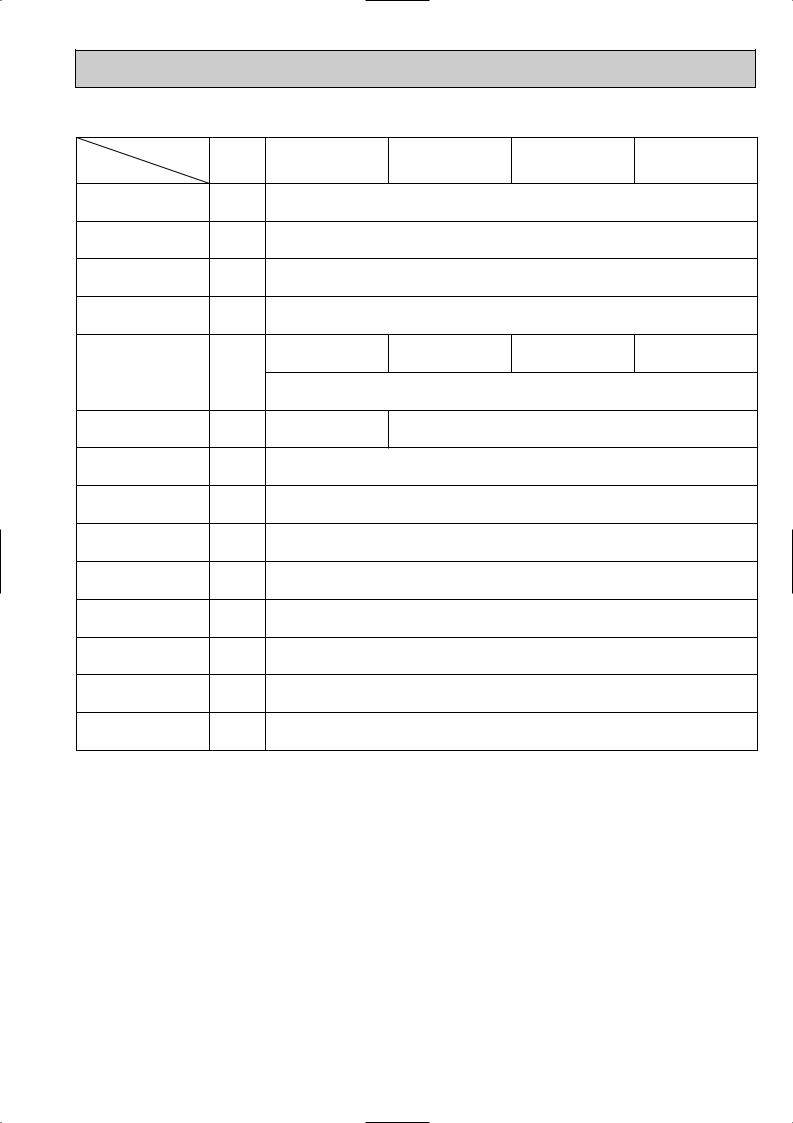
4-2. ELECTRICAL PARTS SPECIFICATIONS
Model |
Symbol |
PLFY-P20VCM-E(1).TH |
PLFY-P25VCM-E(1).TH |
PLFY-P32VCM-E(1).TH |
PLFY-P40VCM-E(1).TH |
|
|||||
Parts name |
|
|
|
|
|
Thermistor |
|
|
|
|
|
(Room temperature |
TH21 |
Resistance 0:/15k", 10:/9.6k", 20:/6.3k", 25:/5.4k", 30:/4.3k", 40:/3.0k" |
|||
detection) |
|
|
|
|
|
Thermistor |
|
|
|
|
|
(Pipe temperature |
TH22 |
Resistance 0:/15k", 10:/9.6k", 20:/6.3k", 25:/5.4k", 30:/4.3k", 40:/3.0k" |
|||
detection/ Liquid) |
|
|
|
|
|
Thermistor |
|
|
|
|
|
(Pipe temperature |
TH23 |
Resistance 0:/15k", 10:/9.6k", 20:/6.3k", 25:/5.4k", 30:/4.3k", 40:/3.0k" |
|||
detection/ Gas) |
|
|
|
|
|
Fuse |
FUSE |
|
250V 6.3A |
|
|
(Indoor controller board) |
|
|
|||
|
|
|
|
|
|
|
|
6-pole OUTPUT 11W |
6-pole OUTPUT 15W |
6-pole OUTPUT 20W 6-pole OUTPUT 20W |
|
Fan motor |
MF |
PK6V11-LF |
PK6V15-LD |
PK6V20-LL |
PK6V20-LM |
|
|
|
|
||
(with Thermal fuse) |
|
|
|
|
|
|
|
Thermal fuse |
OFF 145: i 2: |
|
|
|
|
|
|
||
Fan motor capacitor |
C |
1.0+ 440V |
1.5+ 440V |
|
|
Vane motor |
MV |
|
MSBPC20M13 |
|
|
|
DC12V 300"/phase |
|
|||
|
|
|
|
||
Drain pump |
DP |
|
PLD-12230ME-1 |
|
|
|
INPUT 12/10.8W 24R/Hr |
|
|||
|
|
|
|
||
Drain sensor |
DS |
Thermistor resistance 0:/6k", 10:/3.9k", 20:/2.6k", 25:/2.2k", 30:/1.8k", 40:/1.3k" |
|||
Linear expansion valve |
LEV |
DC12V Stepping motor drive, Port dimension [5.2 (0~2000pulse) |
|||
[coil] |
|
EDM-40YGME |
|
||
|
|
|
|||
Electric heater |
H2 |
|
240V 15W |
|
|
(Condensation proof) |
|
|
|||
|
|
|
|
|
|
Power supply terminal |
TB2 |
|
(L, N, ;) Rated to 330V 30A w |
|
|
block |
|
|
|||
|
|
|
|
|
|
Transmission terminal |
TB5 |
|
(M1, M2, S) Rated to 250V 20A w |
|
|
block |
|
|
|||
|
|
|
|
|
|
MA remote controller |
TB15 |
|
(1, 2) Rated to 250V 10A w |
|
|
terminal block |
|
|
|||
|
|
|
|
|
|
w Note: Refer to WIRING DIAGRAM for the supplied voltage.
9
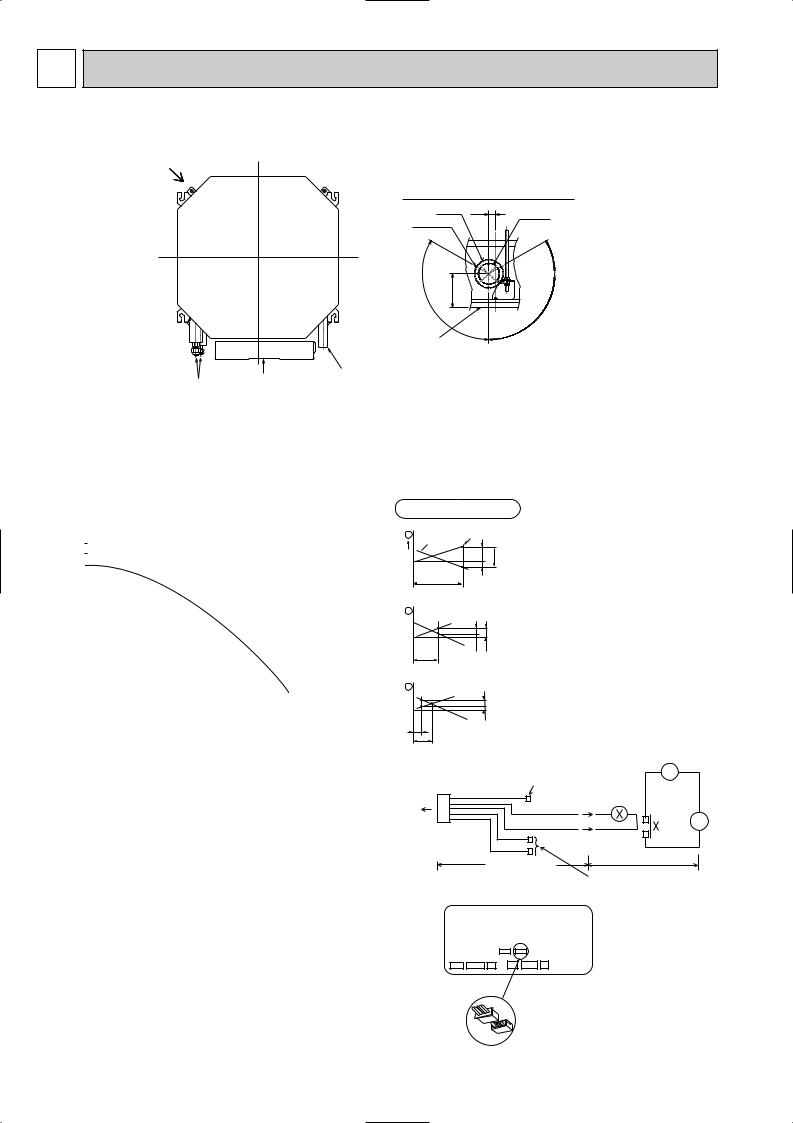
5 4-WAY AIR FLOW SYSTEM
5-1. FRESH AIR INTAKE (Location for installation)
At the time of installation, use the duct holes (cut out) located at the positions shown in following diagram, as and when required.
Fresh air intake
Detail drawing of fresh air intake
[100 |
25 |
|
3-[2.8 hole |
[73.4 |
|
Cut out hole |
||
Burring hole |
|
|
118 |
120 |
° |
120 |
||
° |
|
|
Ceiling surface
Electrical Box |
Drain pipe |
Refrigerant pipe |
|
5-2. FRESH AIR INTAKE AMOUNT & STATIC PRESSURE CHARACTERISTICS
PLFY-P20VCM-E(1).TH
PLFY-P25VCM-E(1).TH
PLFY-P32VCM-E(1).TH
PLFY-P40VCM-E(1).TH
Taking air into the unit
Static pressure : P [Pa] |
|
|
|
|
|
|
Air flow : Q [m3/min] |
|||||||
50 |
|
|
|
|
|
|
|
|
|
|
|
|
||
|
|
|
|
|
|
|
|
|
|
|
|
|||
0 |
0.5 |
1.0 |
1.5 |
2.0 |
2.5 |
3.0 |
3.5 |
|||||||
|
|
|
|
|
|
|
|
|
|
|
|
|
|
|
-50 |
|
|
|
|
|
|
|
|
|
|
|
|
|
|
|
|
|
|
|
|
|
|
|
|
|
|
|
|
|
|
|
|
|
|
|
|
|
|
|
|
|
|
|
|
-100 |
|
|
|
|
|
|
|
|
|
|
|
|
|
|
|
|
|
|
|
|
|
|
|
|
|
|
|
|
|
|
|
|
|
|
|
|
|
|
|
|
|
|
|
|
-150 |
|
|
|
|
|
|
|
|
|
|
|
|
|
|
|
|
|
|
|
|
|
|
|
|
|
|
|
|
|
|
|
|
|
|
|
|
|
|
|
|
|
|
|
|
-200 |
|
|
|
|
|
|
|
|
|
|
|
|
|
|
|
|
|
|
|
|
|
|
|
|
|
|
|
|
|
|
|
|
|
|
|
|
|
|
|
|
|
|
|
|
-250 |
|
|
|
|
|
|
|
|
|
|
|
|
|
|
|
|
|
|
|
|
|
|
|
|
|
|
|
|
|
|
|
|
|
|
|
|
|
|
|
|
|
|
|
|
-300 |
|
|
|
|
|
|
|
|
|
|
|
|
|
|
|
|
|
|
|
|
|
|
|
|
|
|
|
|
|
|
|
|
|
|
|
|
|
|
|
|
|
|
|
|
NOTE: Fresh air intake amount should be 20% or less of whole air amount to prevent dew dripping.
How to read curves
|
Curve in the |
Duct characteristics |
|
1 |
at site |
|
|
left graphs |
|
||
|
|
|
|
0 |
|
A |
C |
|
|
||
|
Q |
B |
|
|
|
|
|
2
A
E C
Q
3 |
D |
A |
Q |
Qa |
Q…Designed amount of fresh air intake <m3/min> A…Static pressure loss of fresh air
intake duct system with air flow amount Q <Pa> B…Forced static pressure at air condi-
tioner inlet with air flow amount Q <Pa>
C…Static pressure of booster fan with air flow amount Q <Pa> D…Static pressure loss increase amount of fresh air intake duct system for air flow amount Q <Pa> E…Static pressure of indoor unit with air flow amount Q <Pa> Qa…Estimated amount of fresh air intake without D <m3/min>
5-3. OPERATION IN CONJUNCTION WITH DUCT FAN (Booster fan)
•Whenever the indoor unit operates, the duct fun also operates.
(1)Connect the optional multiple remote controller adapter(PAC-SA88HA-E) to the connector CN51 on the indoor controller board.
(2)Drive the relay after connecting the 12V DC relay between the Yellow and Orange connector wires.
MB: Electromagnetic switch power relay for duct fan.
X:Auxiliary relay (For DC 12V, coil rating : 1.0W or below)
|
|
|
Be sure to secure insulation |
~ |
|
|
|
|
|
||
|
|
|
material by tape, etc. |
|
|
CN51 |
5 |
Green |
|
|
|
on indoor |
|
|
Yellow |
|
|
controller board |
|
|
|
|
|
1 |
|
Orange |
|
MB |
|
|
|
|
|||
|
Connector (5P) |
Red |
|
|
|
|
|
|
Brown |
|
|
|
Indoor unit side |
Multiple remote |
Installation at site |
||
|
|
|
|
|
|
|
|
|
controller adapter |
Be sure to secure insulation |
|
Indoor controller board |
|
PAC-SA88HA-E |
material by tape, etc. |
||
|
|
|
|
||
|
|
|
|
Distance between indoor |
|
|
|
|
CN51 |
controller board and relay |
|
|
|
|
must be within 10m. |
||
Multiple remote controller adapter PAC-SA88HA-E
CN51
10
